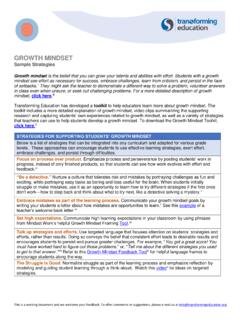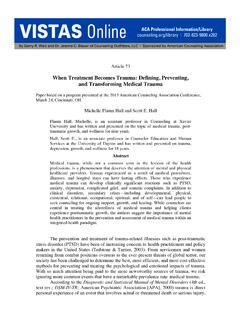Transcription of Artificial intelligence: Transforming the future of banking
1 Artificial intelligence : Transforming the future of banking 00 Artificial intelligence : Transforming the future of banking Contents The importance of AI in banking 1 banking reimagined with AI 2 Organizing for success 4 Conclusion 8 Artificial intelligence : Transforming the future of banking Artificial intelligence : Transforming the future of banking | The importance of AI in banking 1 While the banking sector has long been technology-dependent and data-intensive, new data-enabled AI technology has the capability to drive innovation further and faster than ever before. AI can help improve efficiency, enable a growth agenda, boost differentiation, manage risk and regulatory needs, and positively influence customer experience. Building sophisticated AI systems was once expensive, restricting deployment to key use cases ( , high-frequency trading). Deloitte s recent AI survey of IT and line-of-business executives of companies that have adopted AI technologies found that, from a technology perspective, cost and other barriers to adoption are falling, and it is becoming easier to implement and integrate AI technologies.
2 [1] Organizations are making targeted investments in areas such as cloud, big data platforms, and data applications that use updated architecture ( , microservices and event hubs), eliminating up-front capital investment needed specifically to develop, deploy, and scale AI solutions. However, multiple operational and organizational challenges remain, notably skills gaps and the integration of AI into the wider organization, to name two examples.[1] In this article, we explore several topics supporting AI in the banking industry, including key use cases for banking executives as they consider mainstream deployment of AI, how to enable successful AI implementations, and some shifts required for developing a viable implementation. The importance of AI in banking It would be an understatement to suggest that Artificial intelligence (AI) and machine learning (ML) are transformative technologies. According to a recent Deloitte survey of IT and line-of -business executives, 86% of financial services AI adopters say that AI will be very or critically important to their business s success in the next two years.
3 [1] So, what should banks do to keep current with AI marketplace trends and build with confidence into the future ? Artificial intelligence : Transforming the future of banking | banking reimagined with AI 2 Customer experience and growth More than 50% of bank customers believe personalized services are one of the key factors for them to have trust in their banks, while only 35% of traditional banks offer personalization that meets customers needs at the appropriate time and place.[2] Hence, banks will need to invest (or are investing) more than ever to personalize the services offered to customers and, in turn, retain their trust and loyalty. Banks must employ data-driven AI capabilities to conduct microsegmentation of existing customers and prospects. This level of granularity can help banks more accurately predict customer and prospect needs and behaviors. A large bank has recently used data-driven AI to offer personalized reward programs (related to travel, shopping, etc.)
4 By predicting customers redemption preferences. This resulted in an increase of 40% in reward program usage.[3] Some other banks have also employed next-best action models to predict customers needs proactively and personalize the services offered to them by tracking their financial journey all of which has helped increase sales by almost 30%.[4] banking reimagined with AI As banks consider the pros and cons of a broader enterprise AI strategy, use cases can be instructive in decision-making. By focusing on use cases like the ones that follow, executives can make informed decisions that can help tailor deployments to their circumstances, yielding a better return on investment. While these examples are by no means exhaustive, they demonstrate that data-driven AI can be used in many ways to generate additional value across a banking organization from front-office revenue growth to back-office operational efficiencies. Artificial intelligence : Transforming the future of banking | banking reimagined with AI 3 Service optimization Shuttered branches and an influx of calls about federal coronavirus relief programs created exceptionally long online and telephone wait times for customers (20 180 minutes versus ~40 seconds during normal times).
5 [5] Call centers often hire supplemental staff during peak traffic times, but banks should adopt AI technologies to manage call volume fluctuations. Conversational AI agents can engage in personalized discussions by tapping into data sources that include customer data, social media, current economic conditions, historical customer information, call center patterns, and more. In addition, AI can help improve operational efficiencies in areas such as routing customer calls and calculating appropriate customer hold times. The top 2,000 US corporations spend roughly $250 billion annually on customer support some 50 billion cases, each of which costs around $5 to address and COVID-19 has exacerbated this issue.[6] So, any savings from reducing support ticket volume, time, and costs via AI could positively affect their bottom line.[6] A leading Canadian bank is developing advanced consumer banking AI agents (conversational agents in particular), which can answer hundreds of common questions and can learn to answer additional queries the more it interacts with customers; this would help manage spend while driving consistency and scalability.
6 [7] Underwriting A recent report [6] from Autonomous suggests that by 2030, traditional financial institutions can save up to $31 billion of their underwriting and collection system costs by implementing AI technologies. The COVID-19 pandemic exacerbated several current underwriting concerns, namely volume, speed, and risk. Robotic process automation and ML models and varied data sources can expedite the loan underwriting process and improve risk assessment. This process can be expedited by automating document scanning and manual processes involved to gather relevant data. ML models can run on the data gathered from multiple data sources ( , social media posts and third-party data) and can be used to accurately assess borrowers risk and quickly make loan decisions. A large retailer recently launched a digital credit line for sellers, which uses authorized seller data ( , sales volume and revenue) to identify candidates for credit line offers.
7 A partner bank then offers credit lines to those that meet its underwriting criteria and can expedite loan approvals. The entire process is automated, which reduces the loan approval time to two days, as opposed to the standard approval time of seven days or more.[8] Collections and recovery According to the Quarterly Report on Household Debt and Credit (Q2 2020), total household debt balances add up to $ trillion. Out of this, $512 billion of debt is delinquent, and 73% of it is seriously delinquent.[9] Customers are delinquent for many reasons pandemic-related job losses, a simple missed payment due to lack of reminders, change of address, or collections making recovery a case of one size fits none. As such, banks must customize their outreach, especially during uncertain economic times. AI can drive efficiencies and create preemptive strategies to help customers and lenders alike. Banks can benefit by leveraging customer data to identify warning signals for possible delinquencies and defaults, predict why customers might miss payments, and offer customized solutions to catch up.
8 A Fintech giant that offers AI-driven debt collection assistance, such as using ML to conduct customer-behavior-based personalized communications, has helped its clients recover more than $100 million since its foundation in 2014, and it typically collects 40% to 50% more than traditional collection agencies.[10] Regulatory and risk assessment Banks spend a lot of money to comply with government rules and regulations. In a recent Global Regulatory Outlook 2020,[11] 33% of banks reported that they have allocated or will allocate more than 5% of their annual budgets to compliance in 2020. Although banks are spending a significant amount of their budget on compliance, and AI has been a hot topic, based on Deloitte s State of AI in the Enterprise, 3rd Edition: Financial Services Results,[1] only 4% of the respondents in financial services used AI technologies primarily in legal and compliance functions. Banks can create efficiencies and save money by leveraging AI to automate labor-intensive compliance processes and automatically detect regulatory changes to ensure they remain in compliance.
9 Initial regulatory reporting configurations can take years of effort and still require continual manual supervision to stay current with evolving regulations. The time frame and effort level can be reduced if banks use AI as part of the setup process. Deep learning and natural language processing can help shorten implementation time frames by reading compliance requirements from regulatory websites, notifying banks about updates, and incorporating changes automatically in the systems that generate reports. Artificial intelligence : Transforming the future of banking | Organizing for success 4 Step 1: Develop an AI strategy From just using AI to becoming an AI insights driven organization: Many banks today are defining use cases to implement AI in some capacity within their organizations, from testing AI to creating a marketplace reputation for being tech-savvy. As shown in figure 4, most organizations are either just becoming AI-aware or are using localized AI.
10 However, to stay competitive in both the short and long term, banks must escalate AI as a foundational component instead of treating it as a stand-alone initiative.[12] Bank strategies should evolve from implementing AI on a piecemeal basis to embedding AI in its organization and culture and focus on moving from simply being AI-aware to becoming a strong AI for success Much like the evolution of cloud platforms in recent years, banks must move beyond the hype and consider the practical applications of AI. While there are proven examples of effective applications, many banks still consider AI to be experimental, with many of their pilot programs never moving into full-scale implementation. In the following section, we cover critical focus areas across six steps where banks may need to evolve their processes to be successful on their AI implementation journey. Artificial intelligence : Transforming the future of banking | Organizing for success 5 According to a recent Deloitte survey [13] (see figure 5), frontrunners benefited from early recognition of how critically important AI is to overall business success.

















